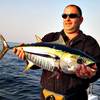You get out on the water, eager to stretch your arms on a fish, and now you do not know where to start. I have many people on the boat with me and they look at the water and see nothing but water. There is a lot more to see and one needs to start training their eyes to learn to identify what is going on.
Wind lines, current lines, up-welling, rips, eddies, tide lines, debris lines, colour lines, reverse currents, vertical and horizontal thermo clines, splashes, birds and currents are all things that one needs to learn to look out for, because when you find these you will find fish and so you need to learn to fish with your eyes open.
Wind lines more often than not accumulate debris, and this debris provides a shelter for small fish which in turn bring larger fish to the area to feed. Wind lines are normally easy to spot as you will see a narrow line of flat water
Up-welling is caused by currents moving over pinnacles and ledges bringing the nutrients from the bottom up towards the surface and creating a feeding area for smaller fish and larger fish will come to prey on these smaller fish. These can often be spotted by seeing water moving in small circular movements.
Vertical thermo clines are very difficult to spot visually but these are pockets of warm water which one can see on the thermometer of you finder, on very still days one would look for water patches that looked like 2 fluids mixed together as this will be the outside of these thermo clines or warm water pockets. Horizontal thermo clines are only visible on your sonar and can easily be identified when you turn the grain right up.
Current lines are always a key area to find fish, usually as you approach a current you will see that the water looks rough and the swells are short and steep, the edges of these currents are hot spots for finding larger fish.
Colour lines are clear and definite lines with 2 different water colours, these are easy to spot especially with Polaroid sunglasses.
Keep a look out for bird activity, especially when you see birds hovering or diving as this is a sure sign of fish activity, with the smaller sea birds their height from the water usually indicates the depth of the fish.
Splashes and boils from bait fish, or feeding game fish is virtually a guarantee of fish feeding activity.
You need to keep your eyes peeled and see what is happening around you, and this will improve your catch rates as it will help you locate fish.
Lastly when you are out there and you think you saw something, you probably did, how many times I have caught a Sailfish because I thought I saw one jump, took a bearing and headed straight to what I thought I saw.


